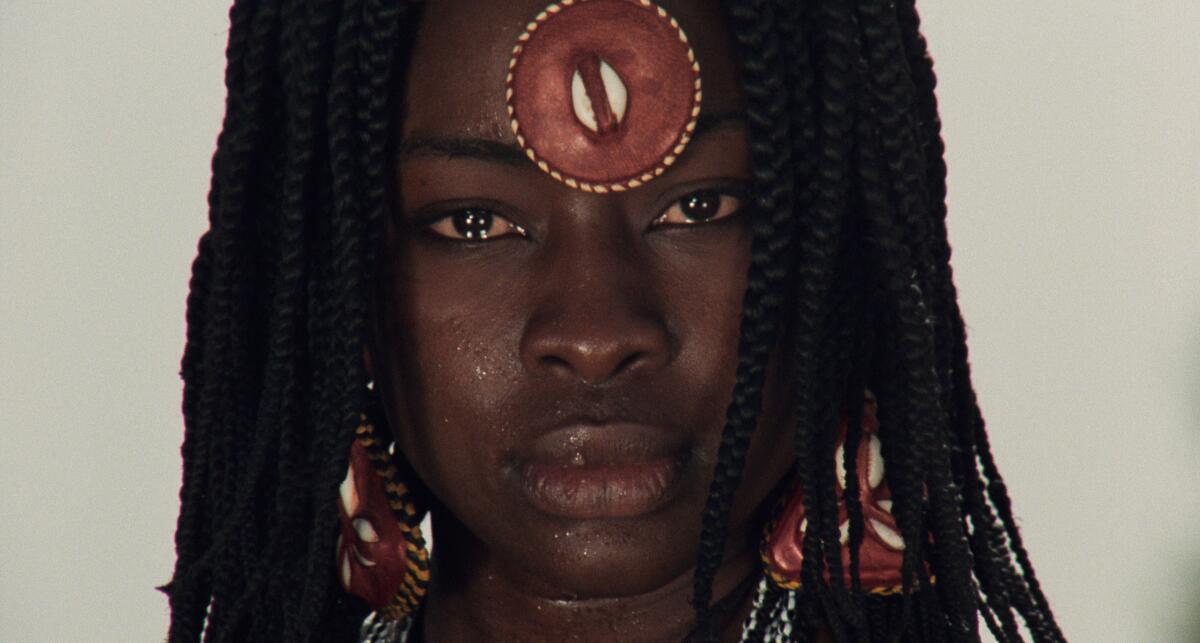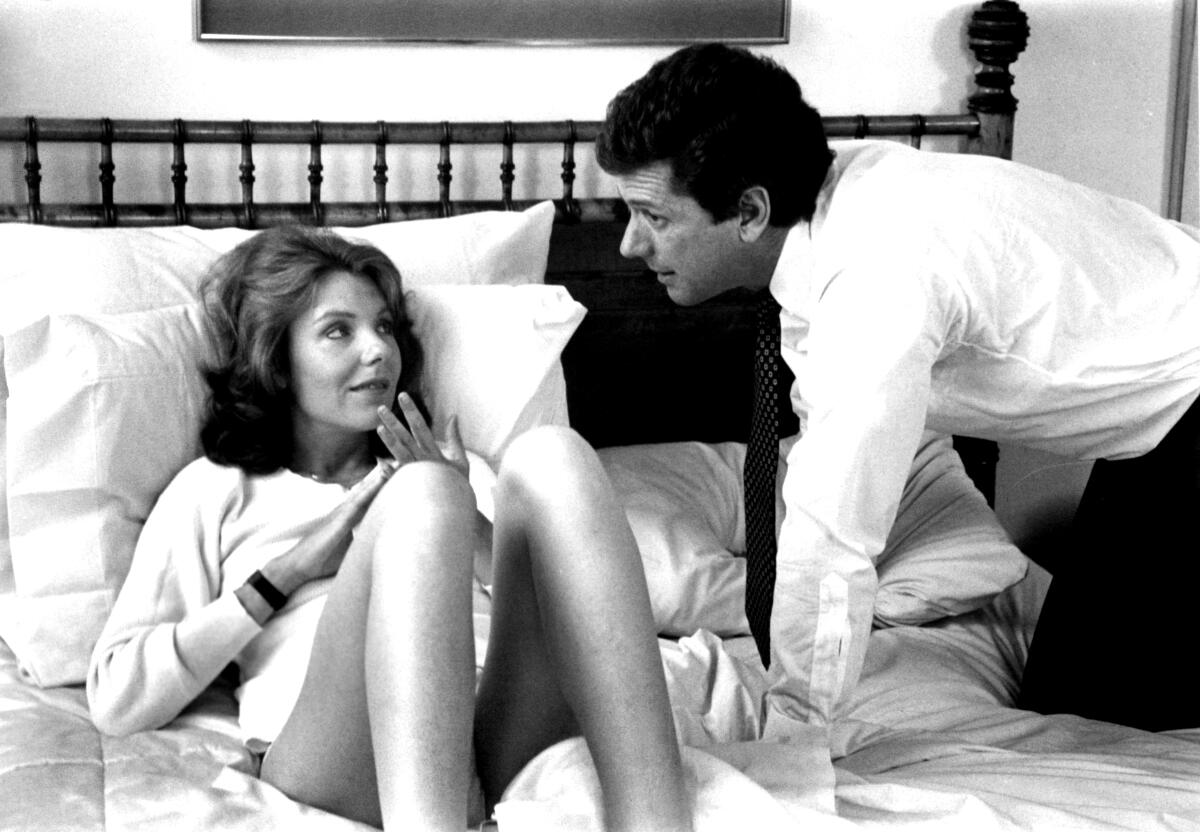A centennial tribute to Ousmane Sembène and more of the best movies in L.A. this week

- Share via
Hello! I’m Mark Olsen. Welcome to another edition of your regular field guide to a world of Only Good Movies.
More from the fests This week I am reaching you from Toronto, Canada, where I‘ll be for the next week — along with my colleagues Jen Yamato and Matt Brennan — covering the Toronto International Film Festival. We all picked some of our most anticipated films for the fest, including the world premieres of Azazel Jacobs’ “His Three Daughters,” Cord Jefferson’s “American Fiction” and Demián Rugna’s “When Evil Lurks.”
Plus there’s lots to look forward to here from the Venice and Telluride fests, including Ava DuVernay’s “Origin,” Harmony Korine’s “Aggro Dr1ft” and Richard Linklater’s “Hit Man.” Although truth be told, arguably the most anticipated event of the festival may be the premiere of the new 4K restoration of Jonathan Demme’s 1983 concert film “Stop Making Sense,” with all four original members of Talking Heads appearing together for the first time in some 20 years.
Justin Chang, Glenn Whipp, Josh Rottenberg and Joshua Rothkopf were all at Telluride and weighed in on some of their favorites of the fest, including Andrew Haigh’s “All of Us Strangers,” Annie Baker’s “Janet Planet” and Yorgos Lanthimos’ “Poor Things.”
Justin and Glenn also went into the highs and lows of Telluride, including Jonathan Glazer’s “The Zone of Interest,” Alexander Payne’s “The Holdovers,” Emerald Fennell’s “Saltburn” and George C. Wolfe’s “Rustin.”
Josh Rottenberg had this extensive investigation into marathon swimmer Diana Nyad, the real-life subject of Elizabeth Chai Vasarhelyi and Jimmy Chin’s “Nyad,” which stars Annette Bening. The biopic premiered at Telluride to a mixed response.
Ousmane Sembène centennial

The American Cinematheque is launching a series in celebration of the centennial of the birth of Ousmane Sembène, frequently referred to as the father of African cinema. The series launches tonight with a 4K restoration of the 1977 film “Ceddo,” an ambitious historical epic about the resistance of common people to the ruling class.
Sembène, who died in 2007 at age 84, was born in Senegal and after fighting in WWII published his first novel in 1956. He would eventually transition to cinema in hopes of reaching more people, making his debut with “Black Girl” in 1966, which would win the prestigious Jean Vigo prize at Cannes. (“Black Girl” plays on Sept. 23 as part of the Cinematheque series.)
Writing about a 1995 Sembène retrospective, Times critic Kenneth Turan said, “For all his desire to address political and social concerns, Sembène is so far from being a didactic director that he refuses to make what he calls ‘poster films.’ Yes, he wants to raise awareness, yes his films are savage, often satiric indictments of his country’s and Africa’s problems, but Sembène greatness lies in how effortlessly his social concerns flow from his very human plots and stories. … Sembène in part sees himself in the role of a griot, a traditional African figure who is part storyteller and poet, part historian and wise man, wanting above all else to be the voice of his otherwise silent people.”
Other films in the series include “Xala” and “Emitaï,” also in new 4K restorations, plus “Mandabi,” “Guelwaar” and his final feature, 2004’s “Moolaadé.”
As Sembène himself once said, “How do you speak to a people? How do you raise people’s consciousness? Through cinema.”
‘An Unmarried Woman’

Next Thursday, Vidiots is screening Paul Mazursky’s 1978 “An Unmarried Woman” in an evening presented by actors Jodi Balfour and Abbi Jacobson. This is arguably the defining performance of Jill Clayburgh, as a woman forced to rediscover her own identity after her husband leaves her. Clayburgh was nominated for an Oscar for the role, Mazursky was nominated for the screenplay and the film for best picture. The movie is not available on streaming (though it is on a Criterion Collection disc for those inclined to physical media), so this is a great chance to catch up with it. In a program note for the Vidiots event, Balfour noted, “This is one of our favourite films of all time. Paul and Jill capture something fresh and exciting, even 40ish years on! The world, the performances, the dialogue, the photography, the themes explored… all with an immediacy and intimacy that stays with you. Or, if you’re us, deeply inspires you.”
The event is already sold out, but limited walk-up tickets should be available.
Other points of interest
“Scrapper” at the Nuart One of the surprise gems of this year’s Sundance Film Festival and winner of the World Cinema Dramatic Grand Jury prize was “Scrapper,” the feature debut from English writer-director Charlotte Regan. Brimming with energy and with charming performances from “Triangle of Sadness” star Harris Dickinson and young Lola Campbell, who manages to be worldly and adorable in uncanny measure, the film is about an absent father reconnecting with his 12-year-old daughter after the death of her mother. It’s a film about two people who have been knocked around by life recognizing themselves in each other. The movie is now playing at the Nuart.
“The Muppet Movie” at the Academy Few films are as perfect as “The Muppet Movie,” which hits the sweet spot of suitable for children while still holding the attention of adults who are young at heart. Kermit and the gang hit the road for Hollywood with dreams of stardom and find themselves chased by nefarious corporate overlords. (Plus, there are the songs by Paul Williams and Kenneth Ascher, such as “The Rainbow Connection” and “Movin’ Right Along.”) The cast of cameos is simply too long to fully mention, but includes Dom DeLuise, Richard Pryor, Bob Hope, Steve Martin, Mel Brooks, Carol Kane, Cloris Leachman and Orson Welles. The Academy Museum is screening the film in 35mm as part of its family matinees series on Saturday.
“Not Fade Away” at Brain Dead The first movie by writer-director David Chase after concluding his landmark television series “The Sopranos,” the film “Not Fade Away” was unfairly treated on its original release in 2012 simply because it was not what was expected. Now, with luck, it can be seen as the moving examination of ambition and youthful drive that it is, telling the story of an early ‘60s rock band that doesn’t make it very far. With terrific performances from John Magaro (generating attention this year for his turn in “Past Lives”), Bella Heathcote and James Gandolfini, the movie deserves a new look. Brain Dead Studios is screening the film on Thursday.
“Legally Blonde”/”10 Things I Hate About You” The New Beverly on Saturday and Sunday will have a double-bill tribute to screenwriters Karen McCullah and Kirsten Smith with 2001‘s “Legally Blonde” and 1999‘s “10 Things I Hate About You.” Both films are wonders at taking premises and characters that would often be treated derisively and giving them a dignity that turns them into something totally fresh.
Hal Hartley on Criterion Channel And a final mention to the Criterion Channel’s astoundingly comprehensive collection of movies by Hal Hartley currently on the streaming service. From his impeccable early run of features from 1989’s “The Unbelievable Truth” to 1997’s “Henry Fool” — as vital as any in defining the tone of ‘90s American independent filmmaking — to more relatively recent films like “Fay Grim” and “Ned Rifle,” this program is a wonderful overview of Hartley’s work, whether you are an old fan or discovering it for the first time.
As Hartley once said to me, “Even back in the ‘90s, if I was feeling pesky I would correct journalists by saying, ‘It’s not so much that I’m an independent filmmaker, as I’m an independent businessman.’ And the reason I’m an independent businessman is the only thing that’s important to me is the quality of the work and second to that is the manner that it gets out to the audience that it’s right for.”
Only good movies
Get the Indie Focus newsletter, Mark Olsen's weekly guide to the world of cinema.
You may occasionally receive promotional content from the Los Angeles Times.




